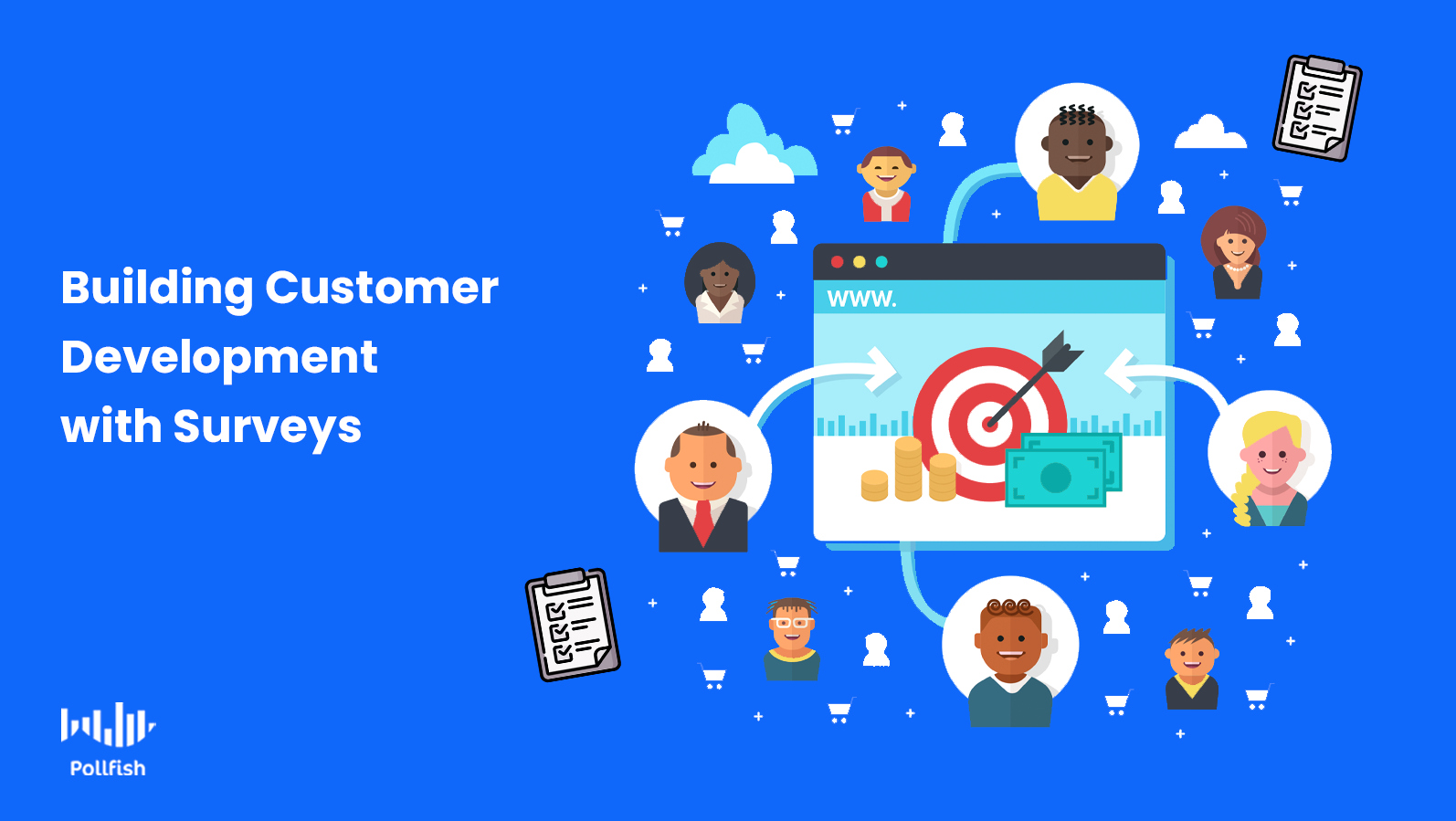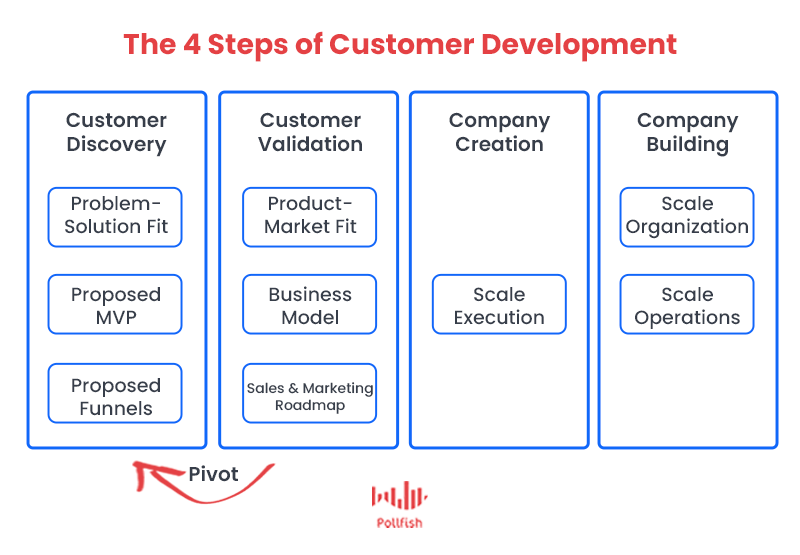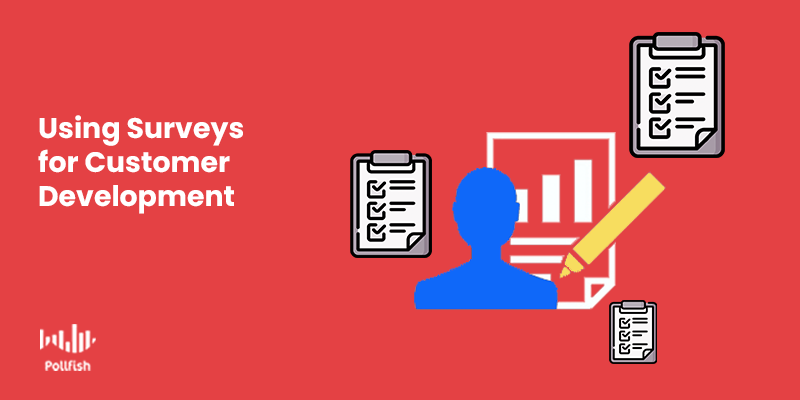How Surveys Foster and Improve Customer Development

Customer development is a specialized method designed to satisfy your customers, a critical need for your business, especially in times of uncertainty.
Specifically aimed at startups, this framework was developed as a part of the Lean Startup methodology, a product development process bent on experimentation, repeated product releases and customer feedback, or VoC.
Customer development ensures that businesses understand market needs before launching a product, allowing them to foster and maintain product satisfaction. As such, all businesses, startups or not can benefit from understanding how to conduct this methodology.
Aside from providing key insights on the general market, surveys can help you attain product development so that you shorten the product development cycle and appease customers.
This article delves into the practice of customer development and expounds on how surveys can both foster and perfect the customer development process.
Defining Customer Development
Customer Development is a structure used to ascertain whether a product satisfies the need(s) of a target market. This framework is part of the lean startup concept, which dictates how startups must form and be managed, in order to bring a product to market more efficiently and grow at scale.
Conceived by entrepreneur Steve Blank, customer development is the mid-portion of the lean startup model, designed specifically to tackle the problem found within product development. As such, it requires to first fully evaluate the product opportunity and then prove that the solution proposed will, in fact, meet market demand and customer needs.
This framework was produced specifically for startups, as Blank observed that startups are not merely smaller versions of more established businesses. Instead, they require their own adapted approach.
As such, the customer development concept was conceived, running counter to traditional product development. Instead, it aims to test if a product will be viable for its target market via the lens of customer demand.
The 4 Steps of Customer Development

- Customer discovery: This is underpinned by understanding your customers and their needs, specifically the kinds that your product/service may be able to fulfill.
- Instead of starting with a hypothesis, customer discovery is set on finding how to make a proposed product/ service best serve customer needs.
- This involves putting together a business strategy and then testing two hypotheses:
- The problem hypothesis: your understanding of customer pain points
- The product hypothesis: your solution to these pain points
- Gain feedback on customer needs, pain points and attitudes on existing or similar products.
- Customer validation: You gain validation via selling your product, after your target market approves of it from Step 1.
- Form an iterative sales process, one bent on scaling. This involves selling to “earlyvangelists,” the customer segment that quickly understands the need for your product.
- Create a business model for the product, using the insights from Step 1. Include value propositions, product positioning and sales collateral.
- Company creation: Work on increasing your demand in this growth strategy stage.
- This stage typically already has an established demand for your product; as such, determine how to heighten the demand.
- It’s crucial to keep gathering customer feedback, conducting market research and using the knowledge you’ve gained to adapt your product.
- This is not an exploratory phase; rather it deals with maintaining your demand retaining customers.
- Company building: Continue supporting the growth of your business.
- This step includes defining the need for certain roles, developing more business departments and hiring more employees as a means of scaling.
- Not every startup will reach this stage, as it is a signifier of company success and a transition from a fledgling business to a full-fledged company.
- Achieving this stage may require redoing the customer validation or creation steps.
The Departments Involved in Customer Development
Although the product team is primarily involved, this is a cross-functional practice. Therefore, it involves a wide range of departments and sub-departments. This includes engineering, marketing, sales and product marketing.
When it comes to understanding the target market, reaching out to it and extracting its opinions, the most fitting teams are the marketing and product teams, as they are largely involved in appealing to the public. Their prowess hinges on talking to existing customers and gaining new ones, so they are the most suitable for outreach.
Additionally, many kinds of martech — software made particularly for marketing, are available to this team for gaining customer data. They can consolidate the data derived from martech, along with other forms of outreach when forming the basis for market needs.
Despite seldom involvement in customer interactions, founders, executives and C-level employees should also take part in this methodology. Their decisions often hold the most weight, and for good reason, as they have the experience and authority to make decisions that steer a business to success. As such, they should work in tandem with the other departments.
The members of higher-up teams must be open to findings and ideas that challenge their own beliefs and hypotheses, as market demand ultimately comes from the customers. Not all executives and founders will see eye to eye with customers, especially when certain target markets are more inclined to change their opinions.
They will have to cooperate with the other departments and leave their egos at the door in order to ensure successful approaches, accurate findings and data-based decisions,
Why Customer Development is Important for Business
This structure is crucial for businesses when it comes to bringing new products and services to market. While it is particular to startups with untested new products, businesses of other sizes and scopes can benefit from executing customer development.
This framework primarily allows businesses to validate the market demand — and to a significant extent — the success of a new product or business idea. It proves or disproves the viability of a new product, which is invaluable.
This is because investing in new solutions is often costly, time-consuming and laborious. It would be a colossal waste of time and money to invest in a product that evokes little to no market demand, especially from your target market, the customers most likely to buy from you.
Thus, customer development protects businesses from investing their resources into unvalidated or unproven products or product ideas.
In addition to this, this methodology helps prove that the product will, indeed, be of use to the customers. These insights help startups or even established companies discover which products are justified to produce and deploy, which require more customer opinions and which to completely disregard.
This process also helps weed out any opinion or intuition a business has, leaving emotions out of key decision-making steps, given that data takes the reigns.
Moreover, performing customer development produces a favorable fundraising outlook for a business. This is because it shows possible investors that the company has performed the necessary steps in validating a product launch. This is especially necessary for startups, which face a larger risk of failing and have less capital than an established business.
After all, investors will seek out stable products, those with a promising chance of profit, rather than products with no proven viability.
Finally, this methodology grants businesses the knowledge that allows them to make prioritizations. By understanding the needs of a target market, a business can produce only the most sought-after products and services, rather than venturing into every possible need its target market has.
How Surveys Help Customer Development

Surveys are necessary to use when taking part in the customer development process, as they not only bolster the process. Rather, they serve as the essential tools for gathering customer feedback, made possible through various kinds of consumer surveys.
They are essential in that customer development is founded on the basis of asking customers and potential customers, i.e., the target market, various questions on their needs, desires, pain points and opinions as they relate to your product or solution.
While it certainly is possible to use focus groups and conduct phone interviews, surveys present a far more efficient solution in gathering feedback. This is because they can be deployed to the masses and obtain responses in a relatively short amount of time (think several days as the maximum).
What’s more is that surveys ensure that you are only obtaining answers from those in your target market. They are granular, as you can target segments of your target market, as well as target respondents based on their responses to screening questions.
Surveys allow you to gain valuable insight through open-ended questions, which, in turn, allows you to derive key insights on how your product idea is viewed and gauge the need for it. As such, these insights are critical for Steps 1 and 2.
However, you can continue strengthening your market research in later steps as well, by applying surrey research, along with other primary research methods. Most importantly, surveys allow you to bypass using other primary sources, as you can ask virtually anything in your surveys to justify product development.
Scaling Your Startup & Business with Continuous Insights
Every startup needs to conduct customer development in order to assure a viable and efficient product launch. Even seasoned businesses can stand to implement this process, as it forgoes unvalidated opinions, the kinds that can set a business up for failure.
Instead, it concentrates on gathering customer information and key insights on market demand, which in turn can confirm speculations and justify new products. Much like its broader lean startup methodology, it grants businesses a formulaic approach to produce and deploy new products and solutions.
Given that surveys are a key component in the process, especially in regards to gaining actionable insights, an agile survey platform is a must. Any errors occurring in the survey process will taint the results, essentially making them biased, void and useless.
To avoid this major inconvenience and waste of time (something that surveys are supposed to save), a business must use an adept online survey tool, the kind that offers ease of question-building, targeting and deployment.
Pollfish Marketing Team
Ready to Try Pollfish?
Create your survey with AI, target high-quality respondents starting at $0.95 per complete, and start getting results in just minutes in real-time. From running a simple product concept survey to managing a constant stream of trackers for dozens of clients in dozens of countries, we’ve got you.
